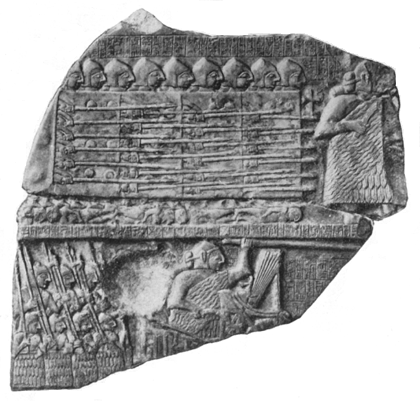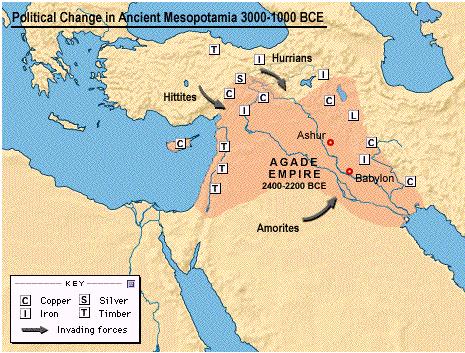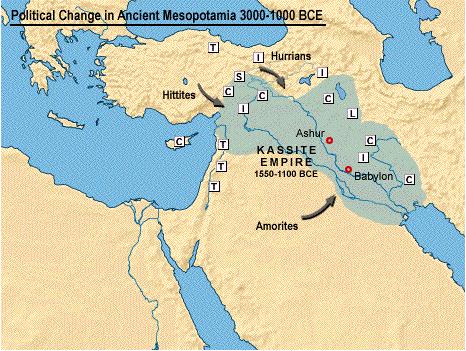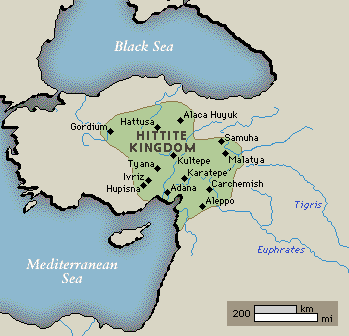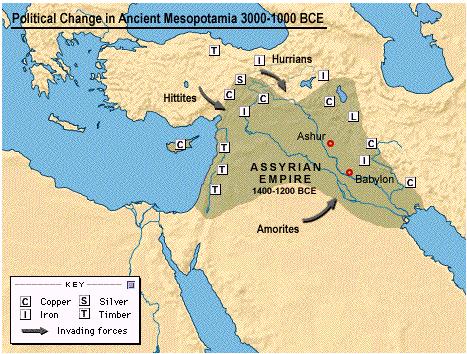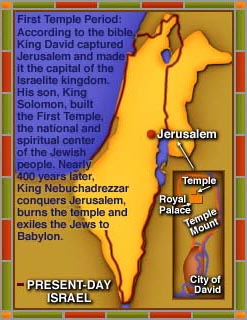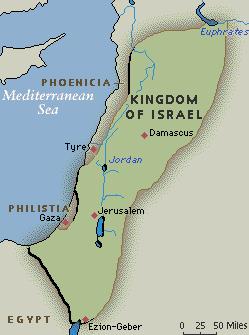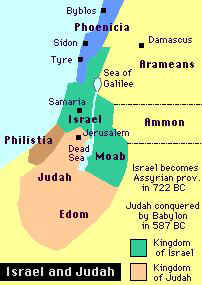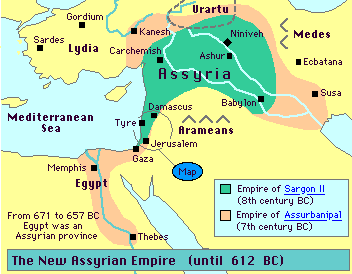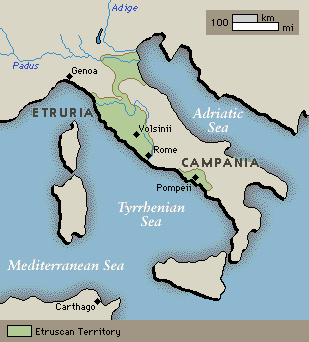Historical Chronology |
![Lightning Bolt [Top]](dark_top.gif)
10,000 B.C. to 601 B.C.
c10,000: Neolithic/Horticultural Age begins: Ice Age glaciers retreat; Mediterranean climate (dry summer) develops, also in California, SW Australia, Chile, SW Africa; deserts appear in subtropics; First horticultural villages appear in western, southern, and eastern Asia, invention of the bow and arrow, dogs and reindeer are domesticated, beginnings of settled agriculture, earliest pottery (Japan); world population c.3 million8500: Jericho founded: walled around 7000 (30 hectares=74 acres) & tower built with flint tools
8000: Copper Age: began in E Mediterranean; world population c.5 million; Sheep and goats are domesticated and the beginnings of rice cultivation in East Asia
c7600-7300: Kennewick Man lived around this time around the banks of the Columbia river in south central Washington state, United States
7419: The "Spirit Cave man" lived around this time in Nevada, United States. Using new dating techniques, researchers discovered that the mummy known as the "Spirit Cave man" was buried 9,417 years ago (as of 1998), about 6,500 years earlier than previously estimated. The mummy was found in 1940 by S.M. and Georgia Wheeler, married archaeologists hired by the state to excavate what they labeled the "Spirit Cave," about 60 miles east of Carson City. Woven bags and other everyday artifacts were found nearby. Two bags contained ashes and bone fragments of two other people who had been cremated. The man had features similar to other earlier skeletons found in North America: a long, relatively small face and a long cranium -- characteristics different than those of modern American Indians.
6800: Jarmo, Kurdistan: earliest known neolithic village?, Emmer wheat; 1947
6500-5650: Catal Hulyuk is settled (village in Turkey)
6000-5300: Halaf Culture inhabited the Kurdish mountains. Named for the ancient mound of Tel Halaf in what is now Syrian Kurdistan (west of the town of Qamishli), this culture is best known for its easily recognizable style of pottery which, fortunately, was produced in abundance. Exquisitely painted, delicately designed Halaf pottery is easily distinguishable from earlier and later productions
6000: Villages in Akkad/Uri & Sumer/Kiengir founded, wheel invented; Village of Ban Po in China founded
5500: Copper smelted from malachite in Persia
5500 - 3100: Predynastic Period in Egypt
5300-4300: The Halaf cultural period ends with the arrival of a new culture, and quite likely a new people: the Ubaidians. 'Ubaid Culture' expanded from the plains of Mesopotamia into the mountains. The Ubaidians, or protoEuphratians, as they are sometimes called, caused a hybrid culture to emerge in the mountains, comprised of their own cultural heritage and that of the earlier Halaf. It predominated in most of Kurdistan and Mesopotamia for the ensuing 1000 years.
Of the language or ethnic affliation of the Ubaidians we know nothing beyond conjecture. However, it is they who gave the names Tigris and Euphrates to the rivers of Kurdistan and Mesopotamia, as well as the names of almost all of the cities we now recognize as Sumerian. The cultural impact of the Ubaidians on the mountain communities could have been vast, though apparently it was not particularly deep.
5000: Maize & bean cultivation in Mexico
4800-3600: Pan-p'o, China: Yang-shao culture; millet, pigs, red painted pottery, weaving, writing; earliest known neolithic site in China; 1952
4800 - 4200: Fayum A Culture in Lower Egypt; Badarian Culture in Upper Egypt
4500-3500: Uruk period of Sumer: Eridu, Ur, Uruk; writing; temples: Al Ubaid & Janna at Eridu, White at Uruk; Mes-Kalam-Dug tomb near Ur; Merimde Culture in Lower Egypt
Sumerian Artifact
4500-1700: Moenjodaro and Harappa in Indus valley dosmeticate wheat, barley, cotton, horses, buffalo, cattle, and writing (undeciphered) - discovered in 1922
Indus Valley Civilization
4300-2000: A new culture, and possibly a new people, came to dominate the Kurdistan mountains: the Hurrians. Of the Hurrians we know much more, and the volume of our knowledge becomes greater with time. We know, for example, that the Hurrians spread far and wide into the Zagros-Taurus mountain systems and intruded for a time on the neighboring plains of Mesopotamia and the Iranian Plateau. However, they never expanded far from the mountains. Their economy was surprisingly integrated and focused, alongwith their political bonds, which ran generally parallel to the Zagros-Taurus mountains rather than radiating out to the lowlands, as was the case during the preceding Ubaid cultural period. Mountainplain economic exchanges remained secondaryin importance, judging by the archaeological remains of goods and their origins.
The Hurrians spoke a language or languages of the northeastern group of the Caucasian family of languages, distantly related to modern Lezgian and, by extension, to Georgian and Laz. The direction of their expansion is not yet understood and by no means should be taken as having been north-south, in other words, as an expansion out of the Caucuses. (It may well be that it was the Hurrians who introduced Caucasian languages into the Caucasus.)
For a long time the states founded by the Hurrians remained small, until around 2500 BC when larger political-military entities evolved out of the older city-states. Four polities are of special note: Urartu, Mushku, Subaru and Guti/Qutil. The kingdom of Mushku is now believed to have brought about the final downfall of the Hittites in Anatolia. Their name survives in the city of Mush/Mus in north central Kurdistan of Turkey. The Subaru, who operated from the areas north of modern Arbil in central Kurdistan, have left their name in the populous and historic Kurdish tribal confederacy of Zubari, who still inhabit the areas north of Arbil. The name of Mount Ararat is a legacy of the Urartu. The Qutils of central and southern Kurdistan, after gradually unifying the smaller mountain principalities, became strong enough in 2250 BC to actually annex Sumeria and the rest of lowland Mesopotamia. A Qutil dynasty ruled Sumeria for 130 years until 2120 BC.
Two legendary empires, Melidi and Aratta, served the Hurrians in their inter-regional trade with the economies outside the mountains. With much certainty, Melidi is to be identified with modern Malatya, while Aratta is probably to be identified with the rich Qutil archaeological site of Godin Teppa near Kangawar in southern Kurdistan. By the middle of the 2nd millennium BC, the culture and people of Kurdistan appear to have been unified under a Hurrian identity. The fundamental legacy of the Hurrians to the present culture of the Kurds is manifest in the realm of religion, mythology, martial arts, and even genetics. Nearly two-thirds of Kurdish tribal, topological and urban names are also likely of Hurrian origin: Buhtan, Talaban, Jelali, Barzan; Mardin, Ziwiya and Dinawar, to name a few. Mythological and religious symbols present in the art of the later Hurrian dynastics such as the Mannaeans of eastern Kurdistan, and the Lullus of the south, present in part what can still be observed in the Kurdish ancient religion of Yazdanism, better known today by its various denominations, such as Alevism, Yezidism, and Yar- sanism (Ahl-i Haqq).
It is fascinating to recognize the origin of many tattooing motifs still used by traditional Kurds to decorate their bodies as replicas of those which appear on Hurrian figurines. One such is the combination that incorporates serpent, sun disc, dog and comb motifs. In fact some of these Hurrian tattoo motifs are also present in the religious decorative arts of the Yezidi Kurds.
By the end of the Hurrian period, Kurdistan seems to have been culturally and ethnically homogenized to form a single civilization which was identified as such by neighboring cultures and peoples.
4200 - 3700: Amratian Culture (Nagada I) in Upper Egypt
c4000: Beginning of Agrarian Revolution; The Culture of Vra
3761: Oct 7: year 1 of Jewish calendar: year of creation (1 a.m.= 1 anno mundi)
3700 - 3250: Gerzean A Culture (Nagada II) in Upper Egypt
3641: Feb 10: zero (origin) in Mayan calendar
3600: Bronze Age: began in E Mediterranean; world population c.85 million; Troy I (Hisarlik, Turkey) founded (discovered in 1870)
3400: Earliest Egyptian hieroglyphic writing, white painted pottery
3300: The Iceman lived around this time. Preserved virtually intact in a glacier just 50 miles from Innsbruck, Austria, Iceman is still the subject of intense medical and scientific interest. Doctors studying Iceman say he was surprisingly healthy. But the ancient European did have at least one modern ailment -- his lungs look like those of a smoker.
Mummified Iceman
3250 - 3100: Gerzean B Culture (Nagada III) in Upper Egypt
3100-2500: Archaic Sumerian Cuneiform literature, Semitic invasion
3000-2200: Early Minoan [Source of Atlantis Myth?]: on Crete, pictographic writing; Old Kingdom of Egypt: Isis & Osiris resurrection cult, 12-month 365-day calendar without solar/lunar adjustment, libraries; Zoser & Imhotep built 1st step pyramid, at Saqqara, 61 meters tall; Snefru built 1st true pyramid at Dashur, conquered Sinai & copper mines; Khufu (Cheops) built Great Pyramid at Giza, 137 meters tall; Khafre built 2nd Great Pyramid & Great Sphinx at Giza; Menkaure built 3rd & last Great Pyramid at Giza, Ra sun god temple at Heliopolis; Pepi's papyrus "Instructions to a Son"
3000: Potato cultivation in Peru; world population c.100 million; Huai-an, China: Ch'ing-lien-kang culture; paddy rice, sheep, dogs, pigs, cattle; 1951; also Lung-shan of Ch'eng-tzu-yai: black & white pottery; 'Great Flood' described by Bible: Noah's Ark?: the Sumerian King list (made in 2125) records the following:
"After kingship had descended from heaven, Eridu became the seat of kingship. In Eridu Aululim reigned 28,800 years as king. Alalgar reigned 36,000 years. Two kings, reigned 64,800 years. Eridu was abandoned and its kingship was carried off to Bad-tabira. . . .
"Total: Five Cities, eight kings, reigned 241,200 years.
"The FLOOD then swept over. After the Flood had swept over, and kingship had descended from heaven, Kish became the seat of Kingship. In Kish .... Total: twenty-three kings, reigned 24,510 years, 3 months, 3 1/2 days. Kish was defeated; its kingship was carried off to Eanna.
"In Eanna, Meskiaggasher, the son of (the sun god) Utu reigned as En (Priest) and Lugal (King) 324 years--Meskiaggasher entered the sea, ascended the mountains. Enmerkar, the son of Meskiaggasher, the king of erech who had built Erech, reigned 420 years as king. Lugalbanda, the shepherd, reigned 1,200 years. Dumuzi the fisherman, whose city was Kua, reigned 100 years. Gilgamesh, whose father was a nomad (?) reigned 126 years. Urnungal, the son of Gilgamesh, reigned 30 years. Labasher reigned 9 years. Ennundaranna reigned 8 years. Meshede reigned 36 years. Melamanna reigned 6 years. Lugalkidul reigned 36 years. Total: twelve kings, reigned 2,130 years. Erech was defeated, its kingship was carried off to Ur...."
Earliest Civilization (Sumer, Egypt, Akkad) from 3200 to 2052 BC
2920-2770: 1st dynasty rulers in Egypt: Menes (Aha), Djer, Wadj, Den (Udimu), Anendjib, Semerkhet, Kaa
2900: Fuxi (Fu Hsi): 1st Chinese King, civilized, yin/yang, myth? [Shu ching]
2800: Etana of Kish united Sumerian city-states Kish, Uruk, Ur, Sippar, Akshak Larak, Nippur, Adab, Umma, Lagash, Bad-tibira, Larsa after "Great Flood"; myth?; base 6 & 12 numbers, metal coins
2770 - 2650: 2nd dyasnty rulers in Egypt: Hetepsekhemwy, Reneb, Ninetjer, Peribsen, Khasekhemwy
2750: Tyre: founded by Phoenicians, also Sidon & Byblos [Herodotus]
2650 - 2152: Old Kingdom in Egypt (Dynasties 3-6): The age of the Pyramid. The pyramids of Giza and Dahshur are built during this period.
2650-2575: 3rd Dynasty rulers in Egypt: Zanakht 2650 - 2630, Netjerykhet (Djoser) 2630 - 2611, Sekhemkhet (Djoser Teti) 2611 - 2603, Khaba 2603 - 2599, Huni 2599 - 2575
2630-2600: Men-barage-si: King of Kish (Kishi), disarmed Elam on east border
2600: Gilgamesh: King of Uruk, "built the walls", Epic of Gilgamesh (see 1200)
2589-2566: The Great Pyramid of Cheops (Khufu) built around this time
2575-2464: 4th Dynasty rulers in Egypt: Snofru 2575 - 2551, Khufu (Cheops) 2551 - 2528, Radjedef 2528 - 2520, Khafre (Chephren) 2520 - 2494, Menkaure (Mycerinus) 2490 - 2472, Shepseskaf 2472 - 2467
2500-2300: Classical Sumerian Cuneiform literature: largely records of Lagash
2500-2300-2205: Yao - Shun: 2nd & 3rd Chinese emperors, myth? [Shu ching]
2494-2465: Ur-Nanshe: King of Lagash, border fights with Umma
2480-2461: Mes-Ane-pada: King of Ur, also "King of Kish" = controlled Sumer?
2466-2455: Akurgal: King of Lagash, son of Ur-Nanshe, lost ground to Umma
2465-2323: 5th Dynasty rulers in Egypt: Userkaf 2465 - 2458, Sahure 2458 - 2446, Neferirkare Kakai 2446 - 2426, Shepseskare Ini 2426 - 2419, Raneferef 2419 - 2416, Niuserre Izi 2416 - 2392, Menkauhor 2396 - 2388, Djedkare Izezi 2388 - 2356, Wenis 2356 - 2323
2454-2425-2405: Eannatum - Enannatum: Kings of Lagash, sons of Akurgal
2450-1850: Early Akkadian (Akkade) Cuneiform literature
Agade/Akkadian Empire (2400-2200 BC)
2421-2410-2401: Elulu - Balulu: Kings of Ur
2404-2375: Entemena: King of Lagash, dug irrigation canal to Tigris river
2400-2391: Shagkush-anna: King of Ur, "Priest King of Sumer, King of Nation"; Gish-Shag-ki-dug: King of Umma
c2400: Mari Tablets: Cuneiform
2380-2361: Lugal-kinishe-dudu: King of Umma, control. Ur & Uruk, Lagash treaty
2351-2340: Uru-inim-gina (Uru-Ka-gina): King of Lagash, reforms, early law?
2350: Town of Ai destroyed & abandoned; Ebla Tablets: from Tell Mardikh in NW Syria, largest single find of 3rd millennium bce Cuneiform texts; discovered 1974
2340-2316: Lugal-zage-si: King of Umma, sacked Lagash, "King of the Countries"
2340-2315: Sargon: King of Akkad, conquered Sumer, "King of the Four Quarters"
2323-2152: 6th Dynasty rulers in Egypt: Teti 2323 - 2291, Pepi I (Meryre) 2289 - 2255, Merenre Nemtyemzaf 2255 - 2246, Pepi II (Neferkare) 2246 - 2152
2315-2307: Rimush: King of Akkad, reign of terror, raided Elam, assassinated
2306-2292: Manishtusu: King of Akkad, lost southern Sumer, assassinated
2300-2000: New Sumerian Cuneiform: Akkadian (Semitic) becomes dominant, Akkad & Sumer mapped, Ishtar & Inanna cult, lunisolar 12-month calendar of alternating 29/30 days each beginning on new crescent plus annual adjust to solar
2300: Enheduana: Ur High Priestess, Sargon's daughter, 1st named author, hymns
2291-2255: Naram-Suen: King of Akkad, Sumer & Elam, "The Mighty One", deified
2217-2193: Shar-kali-sharri: King of Akkad, lost Elam, raided Gutium, assassinated.
2200-1500: Middle Minoan: on Crete, snake & bull cults, mother-goddess, dying god Zeus Kretagenes (dies & born again), olive cultivation, Palace of Minos at Knossos, Phaistos, Mallia, Zakro, base10 numbers with Linear-A script
2183 - 1752: Xia (Hsia) dynasty: China, Yu the Great?, Erlitou palace?, bronze, lunisolar calendar (Hsia-li), 5-tone music scale, equinox & solstice calc. The first prehistoric dynasty is said to be Xia, from about the twenty-first to the sixteenth century B.C. Until scientific excavations were made at early bronze-age sites at Anyang, Henan Province, in 1928, it was difficult to separate myth from reality in regard to the Xia. But since then, and especially in the 1960s and 1970s, archaeologists have uncovered urban sites, bronze implements, and tombs that point to the existence of Xia civilization in the same locations cited in ancient Chinese historical texts. At minimum, the Xia period marked an evolutionary stage between the late neolithic cultures and the typical Chinese urban civilization of the Shang dynasty.
2200: Troy II: sacked in Great Fire, rich walled coastal trade town
2189-2169-2154: Dudu - Shu-Turul: Kings of Akkad, controlled Sumer, decline
2155-2142: Ur-Baba: King of Lagash
2150 - 1986: First Intermediate Period in Egypt (Dynasties 7-11): This was a very troubled time. There was a breakdown of centralized government, with many kings having overlapping reigns. Montuhotep established order from his capital at Thebes.
2150-2135: Dynasties 7 and 8 rule in Egypt
2148-2147: La'arab: King of Gutium, conquered Akkad from east, raided Sumer
2141-2122: Gudea: King of Lagash, "Cylinders of Gudea", son-in-law of Ur-Baba
2135-1986: Dynasties 9 and 10 rule in Egypt
2133-2113: Utukhegal (Utu-hegal): King of Uruk, defeated foreign Gutium dynasty in 2130: Sumerian 'King List' written on clay tablet in 2125 and was dated by the scribe who wrote it in the reign of King Utukhegal of Erech (Uruk)
2112-2095: Ur-Nammu: King of Ur, "Laws of Ur-Nammu": 1st extant law code
2094-2047: Shulgi: King of Ur, son of Ur-Nammu, northwest wall against Dedanum
2074-1986: 11th Dynasty rulers in Egypt: Inyotef I (Sehertawy) 2074 - 2064, Inyotef II (Wahankh) 2064 - 2015, Inyotef III (Nakhtnebtepnefer) 2015 - 2007, Montuhotep II 2007 - 1986
2046-2038-2029: Amar-suena - Shu-Suen: Kings of Ur, sons of Shulgi, Mardu wall
2028-2004: Ibbi-Suen: King of Ur, son of Shu-Suen, invasions, crop failures...
2000-600: 1st of 7 periods of Chinese literature
c2000: Horse riders invaded from central Asia: Scythians, Centaurs, Satyrs; The vanguards of the Indo-European speaking tribal immigrants, such as the Hittites and Mittanis, had arrived in southwestern Asia.
2000-1300: Stonehenge: near Salisbury, England; pre-Druidic
1986 - 1759: Middle Kingdom in Egypt (Dynasties 11-12): This period is marked with foreign trade and enormous building projects. There is a refinement in the making of jewelry. Prosperity and renaissance existed for a long period of time, but eventually, internal problems become apparent; 24 sign alphabet, 24 hours/day, sun-star-water clocks, Edwin Smith Papyrus of medicine & surgery, "Story of Sinuhe", knotted ropes of 3-4-5 right triangle
1986-1937: The 11th Dynasty rulers in Egypt: Montuhotep II (Nebhepetre) 1986 - 1956, Montuhotep III (Sankhkare) 1956 - 1944, Montuhotep IV (Nebtawyre) 1944 - 1937
Babylonian Empire (1950-1600 BC)
1937-1759: 12th Dynasty rulers in Egypt: Amenemhet I (Sehetepibre) 1937 - 1908, Senwosret I (Kheperkare) 1917 - 1872, Amenemhet II (Nubkaure) 1875 - 1840, Senwosret II (Khakheperre) 1842 - 1836, Senwosret III (Khakaure) 1836 - 1817, Amenemhet III (Nimaatre) 1817 - 1772, Amenemhet IV (Maakherure) 1772 - 1763, Neferusobek (Sobekkare) 1763 - 1759
1934-1924: Laws of Lipit-Ishtar of Sumer
1900-1595: Amorites (Mardu) rule Akkad & Sumer (North & South Babylonia)
1900: Laws of Eshnunna of Babylonia
1877: Abraham leaves his home at Haran in Mesopotamia and travels with followers to Palestine
1875-1840: Pharaoh Amenemhet II (Nubkaure): mines in Nubia & Sinai, contact with Crete
1842 - 1836: Pharaoh Sesostris II or Senwosret II (Khakheperre) : Fayyumic depression converted to farm land
1836 - 1817: Pharaoh Sesostris III or Senwosret III (Khakaure): invaded Canaan, fortified Nile 2nd cataract
1822-1763: Rim-Sin: King of Larsa, Sumer; conquered by Hammurapi (Hammurabi)
1813-1781-1741: Shamshi-Adad I - Ishme-Dagan I: Assyrian Kings; Amorites
1792-1750: Hammurabi of Babylon: King of united Babylonia, Marduk cult, Zodiac
1759 - 1570: Second Intermediate Period in Egypt (Dynasties 13-17): Egypt defeated & ruled by Semitic Hyksos "Shepherd Kings". Eventually the Theban princes regain power. Kamose defeats the Hyksos.
1759-1621: 13th Dynasty rulers in Egypt: 21 kings for around 63 years then, Neferhotep I 1696 - 1686
Sihathor 1685 - 1685, Sobekhotep IV 1685 - 1678, Sobekhotep V 1678 - 1674, Iaib 1674 - 1664, Ay 1664 - 1641, 9 kings for circa 20 years1758: Laws of Hammurapi (Hammurabi): "eye for an eye"
1752 - 1111: Shang dynasty: China united around Yellow River plain, Anyang, Cheng-chou, silk, proto-porcelain, sun height in relation to incline of polar axis, magic-squares /permutations /right-triangle-formulas.
Shang Dynasty of China
The Shang dynasty (also called the Yin dynasty in its later stages) is believed to have been founded by a rebel leader who overthrew the last Xia ruler. Its civilization was based on agriculture, augmented by hunting and animal husbandry. Two important events of the period were the development of a writing system, as revealed in archaic Chinese inscriptions found on tortoise shells and flat cattle bones (commonly called oracle bones or, and the use of bronze metallurgy. A number of ceremonial bronze vessels with inscriptions date from the Shang period; the workmanship on the bronzes attests to a high level of civilization.
A line of hereditary Shang kings ruled over much of northern China, and Shang troops fought frequent wars with neighboring settlements and nomadic herdsmen from the inner Asian steppes. The capitals, one of which was at the site of the modern city of Anyang, were centers of glittering court life. Court rituals to propitiate spirits and to honor sacred ancestors were highly developed. In addition to his secular position, the king was the head of the ancestor- and spirit-worship cult. Evidence from the royal tombs indicates that royal personages were buried with articles of value, presumably for use in the afterlife. Perhaps for the same reason, hundreds of commoners, who may have been slaves, were buried alive with the royal corpse.
1749-1712: Samsuiluna: Babylonian King, battled with Kassites, Sealand
1720: The ancient (Canaanite and Israelite) city of Hebron was founded at Tel Rumeida. The city's history has been inseparably linked with the Cave of Machpelah, which the Patriarch Abraham purchased from Ephron the Hittite for 400 silver shekels (Genesis 23), as a family tomb. As recorded in Genesis, the Patriarchs Abraham, Isaac, and Jacob, and the Matriarchs Sarah, Rebecca and Leah, are buried there, and -- according to a Jewish tradition -- Adam and Eve are also buried there.
1662: Hebrews leave Canaan and move to Egypt
c1650: Hattusilis I: King of the Hittites, founded Hittite Empire (c1650-1200)
1621-1539: 14th Dynasty rules Egypt, 15th Dynasty rulers in Egypt: Salitis, Bnon, Apachnan (Khian), Apophis (Auserre Apepi), Khamudi, 16th Dynasty rules in Egypt, 17th Dynasty rulers in Egypt: Tao I (Senakhtenre), Tao II (Sekenenre), Kamose (Wadjkheperre)
1600-1100: Mycenaeans: of mainland Greece, Palace of Mycenae, Linear-B script
1595: Mursilis I the Hittite sacked Babylon ending Hammurapi (Amorite) dynasty
1595-1157: Kassites (mountain peoples?) ruled Babylonia (Akkad & Sumer)
Kassite Empire (1550-1100 BC)
1570-c1240: Hebrews enslaved in Egypt
1539 - 1070: New Kingdom (Dynasties 18-20) founded by Pharaoh Amasis I or Ahmose (Nebpehtyre) who overthrew the Hyksos: Extreme prosperity and renaissance in art and building projects mark the beginning of this period. Towards the end of the 19th Dynasty the increasing power of the priesthood corrupts the central government. During the 20th Dynasty tomb robbing is done by officials. The priesthood becomes hereditary and begins to assume secular power. The government breaks down.
1539-1295: 18th dynasty rulers in Egypt: Ahmose (Nebpehtyre) 1539 - 1514, Amenhotep I (Djeserkare) 1514 - 1493, Thutmose I (Akheperkare) 1493 - 1481, Thutmose II (Akheperenre) 1481 - 1479, Hatshepsut (Maatkare) 1473 - 1458, Thutmose III (Menkheperre) 1479 - 1425, Amenhotep II (Akheperure) 1427 - 1392, Thutmose IV (Menkheperure) 1392 - 1382, Amenhotep III (Nebmaatre) 1382 - 1344, Amenhotep IV / Akhenaten 1352 - 1336, Neferneferuaten 1341 - 1337, Smenkhkare (Ankhkheperure) 1337 - 1336, Tutankhamun (Nebkheperure) 1336 - 1327, Ay (Kheperkheperure) 1327 - 1323, Horemheb (Djeserkheperure) 1323 - 1295
1525-1510: Telipinus: King of the Hittites
1520, 1470: Santorini, Greece destroyed in major eruptions [Plato's Atlantis?]
1500-700: Vedic period of Indian Sanskrit lit.: "Rig-Veda", Aryans invade valley of the River Indus
1500-1200: Akkadian Cuneiform became common language of Near East
1500-1000: Late Minoan: on Crete, Mycenaean influence, Linear-B script
c1500: Iron Age: by Hittites near Black Sea, "metal from heaven" = meteorites; Medes & Persians invaded Iranian plateau; Parattarna: 1st King of Mitanni, capital at Washukanni between Hittites & Assyria; Nuzi Tablets: Cuneiform, found near Kirkuk, Iraq
Sheep bones carved with Chinese characters are created. Characters found on the bones include an upside-down "V" that experts deciphered as the Chinese word for "six" and a symbol that means "divination,". Six other characters carved roughly but deeply onto the two fragments of shoulder blade have not been deciphered as of 1998. The bones were unearthed from a pit at an ancient sacrificial site in east China's Shandong province but Xinhua did not report when they were discovered.
In ancient China, bones were used by soothsayers who attempted to divine the future. These fortunetellers heated bones or turtle shells until they cracked and then "read" the fissures in the bone or shell to predict the likelihood of such things as rainfall. In China's Shang Dynasty, more than 3,000 years ago, divining was often used by kings who wanted to know their future or have problems answered. Sometimes the forecast and eventual outcome were carved onto bones, a procedure that has provided some of the earliest known examples of Chinese writing.
Bones with inscriptions written by oracles were first found in central China's Henan province in ruins dating back to the late Shang Dynasty, around 1200 B.C. Xinhua said. So far, only about 1,000 of the more than 10,000 characters found in Henan have been deciphered, it added. Inscriptions on the Shandong sheep blades, meanwhile, are believed to be nearly 300 years older than those found in Henan, offering even earlier clues about the development of Chinese language, Xinhua said.
The bones, which had been burnt, were stored at the bottom of a pit crisscrossed with beams. Pottery and stoneware found with the bones were typical of China's ancient Yueshi culture that existed from 1500 B.C. to 2000 B.C., Xinhua said. It quoted unnamed experts as saying that the inscriptions on the sheep bones "are the oldest written language ever found."
But there are even earlier examples of Chinese writing, with the earliest being symbols on neolithic pottery found near Xi'an, home of China's famed terra cotta warriors, that dates back as far as 8,000 to 5,000 B.C, according to the Cambridge Encyclopedia of China.
1480-1450: Idrimi: King of Alalakh (Tell Atshanah IV) Syria, Cuneiform Tablets
1479-1425: Pharaoh Thutmose III (Menkheperre): conquered & annexed Canaan, Syria, Sudan
1447: Hebrew Exodus lead by Prophet Moses: Hebrews wander in the Sinai desert for 40 years
1427-1392: Pharaoh Amenhotep II (Akheperure): 3 Asian (Canaan & Syria) military campaigns
1392-1382: Pharaoh Thutmose IV (Menkheperure): "Conqueror of Haru (Canaan & Syria)", & Nubia
1390-1355: Tushratta: King of Mitanni (Hanigalbat,Hurrian,Horites), assassinated.
1382-1344: Pharaoh Amenhotep III (Nebmaatre): height of empire, Babylonian correspondence 14th: Ugarit (Ras Shamra, Syria): 30-sign alphabet using Cuneiform on clay
1375-1334: Suppiluliumas I: King of the Hittites, height of Hittite Empire, built Emar (Tell Meskene, Syria): Akkadian Cuneiform tablets found in 1972
Hittite Kingdom circa 1350 BC
1374-1360-1333: Kadashman-Enlil - Burnaburiash II: Babylonian Kings
1363-1328: Ashur-uballit I: Assyrian King, founded Assyrian Empire (1363-612)
Assyrian Empire (1400-1200 BC)
1352-1336: Amarna period of Egypt: Pharaoh Amenhotep IV / Akhenaten, Queen Nefertiti (Smenkhare?), 1st Monotheist?, built capital at Amarna, Cuneiform tablets found in 1887, "Hymns to Aton", Ps 118:22-23?, 'realism' in art
1336-1327: Pharaoh Tutankhamen
1334-1306: Mursilis II: Hittite King, empire reached Aegean Sea? Syria?
1332-1308: Kurigalzu II: Babylonian King, campaigned against Elam & Assyria
1323-1295: Pharaoh Horemheb (Djeserkheperure)
1306-1282: Muwatallis: Hittite King, fought with Egypt for control of Syria
1300: ancient site of Jericho abandoned, wall had fallen in 2350; 1st wave of Hebrew Canaan invasion from Kadesh-barnea by Joshua [Nm 33]
1300-600: Olmec culture of Mexico flourishes
1295-1186: 19th Dynasty rulers in Egypt: Ramses I (Menpehtyre) 1295 - 1294, Seti I (Menmaatre) 1294 - 1279, Ramses II (Usermaatresetepenre) 1279 - 1213, Merenptah (Baenrehotephirmaat) 1213 - 1203, Amenmesse (Menmire) 1203 - 1200, Seti II (Userkheperuresetepenre) 1200 - 1194, Siptah (Akhenresetepenre) 1194 - 1188, Tausert (Sitremeritamun) 1188 - 1186
1294-1279: Pharaoh Seti I (Menmaatre): conquered Libya, Canaan campaigns to check Hittite advance
1288: Battle of Kadesh: Egypt v. Hittites, Hittites advanced south to Damascus
1279-1213: Pharaoh Ramses II (Usermaatresetepenre): period of Hebrew (Egyptian: 'aperu?) Exodus?
1273-1244-1207: Shalmaneser I - Tukulti-Ninurta I: Assyrian Kings;found Nimrud
1269: peace treaty between Ramses II of Egypt & Hattusilis III the Hittite, Egyptian bases at Damascus & Sumur on coast, Hittites just north in Syria
Go to Top
1250-1200: Lachish, Kirjath-sepher/Debir, Eglon, Hazor, Bethel destroyed
1250: Troy VI: sacked (Homer's Trojan War? Earthquakes? Sea Peoples?)
c1250: 2nd wave of Hebrew Canaan invasion from Kadesh-barnea by Leah [Nm 21:21]; Lachish Bowl: 7 letters of proto-Canaanite left-to-right writing, 1935
c1240: Egyptian Book of the Dead written
1234: Tukulti-Ninurta I of Assyria sacked Babylon, took golden Marduk god
1219: Sea Peoples: attack Egypt; Libyan, Shardana, Lukka, Teresh, Shekelesh, Ekwesh
'Sea Peoples' in the Late Bronze Age
1213-1203: Pharaoh Merenptah (Baenrehotephirmaat): plundered Canaan, defeated Askelon, captured Gezer, annihilated Yaro'am (town just south of Lake Galilee): "Israel [male gender, a tribe not a land] is laid waste and his seed is not.", earliest known reference to Israel
c1200-1020: Hebrew Joshua and his successors (the Judges) begin conquest of Palestine
1200: Gilgamesh Epic: 12 tablets compiled in Uruk by Sin-liqiunninni (see 2600); Hittite Empire (c1650-1200) is destroyed by the Kingdom of Mushku (a Hurrian state); camel domesticated by fully nomadic Arabian Desert tribes (Bedouin); Phoenician alphabet of 22 consonants; The Hindu avatar, Krishna, lives around this time?; The avalanche of Indo-European tribes occurred around this time, raining havoc on the economy and settled culture in the mountains and lowlands alike of Kurdistan. The north was settled by the Haiks, known to us as the Armenians, while the rest of the mountains became targets of settlement for various Iranic peoples, such as the Medes, Persians, Scythians, Sarmathians and Sagarthians (whose name survives in the name of the Zagros mountains).
1200-900/750: 1st Dark Age: Many city-states and kingdoms in the Near East and Greece were weakened or obliterated in the disruptions of the period 1200-1000 B.C., and these misfortunes brought grinding poverty to many of the people who did survive the troubles of this age. Enormous difficulties impede our understanding of the history of this troubled period and of the period of recovery that followed because few literary or documentary sources exist to supplement the incomplete information provided by archaeology. Both because conditions were so gloomy for so many people and because we have only a dim view of what happened in these years, it is customary to refer to the era beginning in the twelfth/eleventh centuries as a Dark Age: the fortunes of the people of the time seem generally dark, as does our understanding of the period. The Near East recovered its strength much sooner than did Greece, ending its Dark Age by around 900 B.C. The Greeks did not fully recover until perhaps a hundred and fifty years after that.
1186-1069: 20th Dynasty rulers in Egypt: Setakht (Userkhauremeryamun) 1186 - 1184, Ramesses III (Usermaatremeryamun) 1184 - 1153, Ramesses IV (Hekamaatresetepenamun) 1153 - 1147, Ramesses V (Usermaatresekheperenre) 1147 - 1143, Ramesses VI (Nebmaatremeryamun) 1143 - 1136, Ramesses VII (Usermaatresetepenre) 1136 - 1129, Ramesses VIII (Usermaatreakhenamun) 1129 - 1126, Ramesses IX (Neferkaresetepenre) 1126 - 1108, Ramesses X (Khepermaatresetepenre) 1108 - 1099, Ramesses XI (Menmaatresetepenptah) 1099 - 1069
1184-1153: Pharaoh Ramses III (Usermaatremeryamun) : last of the great Egyptian Kings
1183: Sea Peoples: attack Ramses in Canaan; Tjeker, Denyen, Peleset, Weshesh
1180: Troy VIIa: sacked (Sea Peoples? ...) [walled area c.2x Troy II]
1157: Elam conquered Babylonia, ended Kassite dynasty, took golden Marduk god
c1150: Wen Wang: King of Zhou (western) China, "Count of the West", I Ching?
1146-1123: Nebuchadnezzar I: Babylonian King, reclaimed Marduk god from Elam, Enuma Elish standardized on 7 Tablets in Cuneiform (1876)
c1125: Battle of Deborah: Israel v. Canaan, key battle for Hebrews [Judg 4,5]
1111-771: Western Zhou (Chou) dynasty of China: western at Hao, eastern at Luoyi, Beijing founded, script fully developed (Chou wen), brush & ink painting.
The last Shang ruler, a despot according to standard Chinese accounts, was overthrown by a chieftain of a frontier tribe called Zhou, which had settled in the Wei Valley in modern Shaanxi Province. The Zhou dynasty had its capital at Hao, near the city of Xi'an , or Chang'an, as it was known in its heyday in the imperial period. Sharing the language and culture of the Shang, the early Zhou rulers, through conquest and colonization, gradually sinicized, that is, extended Shang culture through much of China Proper north of the Chang Jiang (Yangtze River). The Zhou dynasty lasted longer than any other, from 1111 to 221 B.C. It was philosophers of this period who first enunciated the doctrine of the "mandate of heaven" (tianming), the notion that the ruler (the "son of heaven" or governed by divine right but that his dethronement would prove that he had lost the mandate. The doctrine explained and justified the demise of the two earlier dynasties and at the same time supported the legitimacy of present and future rulers.
The term feudal has often been applied to the Zhou period because the Zhou's early decentralized rule invites comparison with medieval rule in Europe. At most, however, the early Zhou system was proto-feudal, being a more sophisticated version of earlier tribal organization, in which effective control depended more on familial ties than on feudal legal bonds. Whatever feudal elements there may have been decreased as time went on. The Zhou amalgam of city-states became progressively centralized and established increasingly impersonal political and economic institutions. These developments, which probably occurred in the latter Zhou period, were manifested in greater central control over local governments and a more routinized agricultural taxation.
In 771 B.C. the Zhou court was sacked, and its king was killed by invading barbarians who were allied with rebel lords. The capital was moved eastward to Luoyang in present-day Henan Province. Because of this shift, historians divide the Zhou era into Western Zhou (1111-771 B.C.) and Eastern Zhou (770-221 B.C.). With the royal line broken, the power of the Zhou court gradually diminished; the fragmentation of the kingdom accelerated. Eastern Zhou divides into two subperiods. The first, from 770 to 476 B.C., is called the Spring and Autumn Period, after a famous historical chronicle of the time; the second is known as the Warring States Period (475-221 B.C.).
1116-1078: Tiglath-pileser I: Assyrian King, conquered Babylonia but prevented from taking Syria by Arameans who controlled & occupied Syria at this time
1100-400: Chavin culture of Peru
c1100: Izbet Sartah Abecedary potsherd: Old Hebrew alphabet left-to-right; 1974
1070 - 715: The 3rd Intermediate Period of Egypt (Dynasties 21-24), Assyrian Domination: The capital moves from Tanis to Libya, to Nubia, to Thebes, to Sais, and then back to Nubia and Thebes.
1070-945: 21st Dynasty rulers in Egypt: Smedes 1070-1044, Amenemnisu 1040, Psusennes I 1040-992, Amenope 993-984, Osochor 984-978, Siamun 978-959, Psusennes II 959-945
c1050: Philistines: Peleset Sea Peoples?, settled in Gaza, Ashkelon, Ashdod, Gath, Ekron; defeated Hebrews in Battle of Aphek; sacked Shiloh [1 Sam 4]
1020-1000: Saul: first King of Israel, defeated by Philistines [1 Sam. 11:15]
1000-961: David: King of united Israel, capital/fortress Jerusalem, Ark of Covenant, gained control of "King's Highway" trade route from Damascus to Edom, traded with Phoenicians at Tyre & Sidon, quelled internal revolts
Israel under King David
1000-586: 1st period (Classical) of Hebrew literature in Old Hebrew alphabet: Song of Deborah [Jdg 5], Song of Miriam [Exo 15:1-18], Song of Songs
c1000: Troy VIIb2: Thracian settlement, site abandoned? (rebuilt as Ilium c700); King Ahiram of Byblos Sarcophagus Inscription: in Phoenician alphabet 10th: Greek alphabet, Ionians exiled from Greece to Asia Minor where they founded 12 cities including Miletus & Ephesus, Temple of Hera in Olympia; India: steel, 360 day calendar with solar adjustment; Persian Prophet Zoroaster (Zarathushtra) lived around this time?: Zoroastrianism founded; Medes and Persians arrived on the eastern flanks of the Zagros mountains (South West Asia)
1000-950: Southern Arabian Peninsula (modern Yemen) was ruled by the Mineans. The kingdom depended for their wealth on the spice trade. Aromatics such as myrrh and frankincense were greatly prized in the ancient civilized world and were used as part of various rituals in many cultures, including Egyptian, Greek and Roman. In the 11th century BC, land routes through Arabia were greatly improved by using the camel as a beast of burden, and frankincense was carried from its production centre at Qana (now known as Bir 'Ali) to Gaza in Egypt. The camel caravans also carried gold and other precious goods which arrived in Qana by sea from India. The Minaeans established their capital at Karna (now known as Sadah)
961-922: Solomon: King of Israel, Jerusalem Temple, "Ten Commandments", height of culture, reign of peace, controlled Via Maris (Sea Road) trade route along Philistian coast, leading trade state between Egypt & Asia Minor, married Pharaoh's daughter, spice trade with Queen of Sheba (Sabaeans?), sea route from Ezion-geber on Red Sea to Ophir Africa, mines
Israel under King Solomon
950-115: The Minaeans of southern Arabia are superseded by the Sabaeans. The Sabaean capital was Ma'rib, where a large temple was built - Sabaean civilization reached its peak with the transfer of power from the mukarribs (priest-kings) to autocratic monarchs (7th century BC). The ancient city, in a fertile oasis irrigated by the impounded waters of the Ma'rib Dam, has been called "the Paris of the ancient world." It was on one of the principal caravan routes that linked the Mediterranean world and the Arabian Peninsula, and it prospered especially because of its trading monopoly of frankincense and myrrh from Yemen and the southern coastal region of Hadhramaut.
The Sabaean civilization was based not only on the spice trade, but also on agriculture. The impressive dam, built at Ma'rib in the 8th century BC, provided irrigation for farmland and stood for over a millennium. Some Sabaean carved inscriptions from this period are still extant. The Himyarites established their capital at Dhafar (now just a small village in the Ibb region) and gradually absorbed the Sabaean kingdom. They were culturally inferior to the Sabaeans and traded from the port of al-Muza on the Red Sea. By the first century BC, the area had been conquered by the Romans.
945-712: 22nd dynasty rulers in Egypt: Shoshenq I 945-924, Osorkon I 924-909, Takelot 909--?, Shoshenq II ?--883, Osorkon II 883-855, Takelot II 860-835, Shoshenq III 835-783, Pami 783-773
Shoshenq IV 773-735, Osorkon IV 735-712945-924: Pharaoh Shoshenq I: founded Libyan Dynasty (22nd, 945-712) at Tanis, harbored Israel's Jeroboam, seeded split [1 Kings 11:40], Jerusalem spared after Rehoboam payed tribute of Temple & Palace treasures [1 Kings 14:25,2 Chr 12:2-9]
934-912-891: Ashur-dan II - Adad-nerari II: Assyrian Kings, wars with Syria
922: United Israel split into Israel & Judah; Ammon, Moab, Edom independent
The Kingdoms of Israel and Judah
922-907: Jeroboam I: King of Israel (Northern Kingdom, 10 tribes) [1 Kings 11-14...]
922-917: Rehoboam I: King of Judah (Southern Kingdom, 2 tribes:Judah, Benjamin)
917-908: Abijam: King of Judah, son of Rehoboam, campaigned against Israel
908-867: Asa: King of Judah, son of Abijam [1 Kings 14:31-15:24,1 Chr 3:10, 2 Chr 13-16]
907-906: Nadab: King of Israel, son of Jeroboam [1 Kings 14:20, 15:25-31]
906-883: Baasha ben Ahijah: King of Israel, killed entire Jeroboam family 9th: Babylonian Akkadian Cuneiform becomes common language of Mediterranean; Dorian Greeks invaded Peloponnesus & settled in Corinth; King Menelik I of Ethiopia the son of King Solomon of Israel & Queen of Sheba, myth?
890-884-860: Tukulti-Ninurta II - Ashurnasirpal II: Assyrian Kings; Syrian wars
883: Ben-hadad I King of Damascus sacked Israel for Asa of Judah [1 Kings 15:17-20]
882-871: Omri: King of Israel, Judah & Tyre alliance, founded Samaria in 879
880-844: Aramu: King of Urartu (Armenia); Urartu Tablets in Akkadian Cuneiform
879-842: Ben-hadad II: King of Damascus (Syria, Aram), murdered by Hazael
871-852: Ahab: King of Israel, son of Omri, regained King's Highway, married King of Tyre's daughter Jezebel bringing cult of Melqart & temple to Samaria
859-825-812: Shalmaneser III - Shamshi-Adad V: Assyrian Kings
853: Battle of Qarqar: Assyria defeated by Syrian alliance which included Ahab
851-842: Jehoram: King of Israel, son of Ahab [2 Kings 1:17, 3:1, 5-9,2 Chr 22:5-6]
850: Mesha Victory Stele: stone in Old Hebrew, records victory (attributed to Chemosh god) of King Mesha of Moab against Kings Omri & Ahab, 1868 [cf. 2 Kings 3]; Homer: Greek Epic Poet, pseudonym?, "Iliad & Odyssey"; By this time the last Hurrian states had been extinguished by the invading Aryans, whose sheer numbers of immigrants must have been considerable. They succeeded over time in changing the Hurrian language(s) of the people in Kurdistan, as well as their genetic make-up. By the 3rd century BC, the Aryanization of the Kurdistan mountains was virtually complete.
849, 848, 845: Assyrian campaigns against Syrian alliance
842-c796: Hazael: King of Damascus; took Ammon, Moab, Edom in 814
842-815: Jehu: King of Israel, with Elisha killed Jehoram,Jezebel,Ahaziah,all Ahab's offspring & followers & destroyed Melqart temple in Samaria [2 Kings 9-12]
828-725: 23rd Dynasty rulers in Egypt: Pedubaste I 828-803, Osorkon IV 777-749, Peftjauwybast 740-725
814-800: Jehoahaz: King of Israel, son of Jehu [2 Kings 10:35;13:1-9]
814: Carthage: founded by Elissa & Pygmalion of Tyre, myth?
810-783: Adad-nerara III: Assyrian King, sacked Damascus in 796 [2 Kings 13:5]
800-500: Dharma-sutra period of Indian Sanskrit literature: "Upanishads"
800-784: Joash: King of Israel, sacked Jerusalem, raided Temple in 785 8th: High Priestess of Thebes, Apollo worshipped at Delphi, Spartan Laws of Lycurgus, Laws of Minos of Knossos; Babylonian 5 & 7 tone music scales; Egyptian fable: "Battle of Head & Belly"; Syria adopts Aramaic
798-769: Amaziah: King of Judah, regained Edom, defeated by Israel [2 Kings 14:7-22]
785-760: Argishti I: King of Urartu (Armenia), founded Erevan in 782
784-733: Uzziah: prince-regent then King of Judah, son of Amaziah [2 Kings 15:1-7, 2 Chr 26:1-3], Yahwist (J) source of Genesis-Numbers (Mosaic Law) written
784-748: Jeroboam II: son of Joash, last important ruler of Israel [2 Kings 14:23], Elowist (E) source of Genesis-Exodus (Mosaic Law), Hosea, Amos, Micah written
776-393ce: Olympic Games: every 4th year at Olympia, women excluded
775 Sep 6: solar eclipse recorded in China
772: Temple of Artemis at Ephesus begun, original burned in 356
770-221: Eastern Zhou (Chou) dynasty of China: Spring & Autumn period to 476, bronze casting perfected, "Quarter-Remainder Calendar" of 365.25 days/year [ssu-fen-li,Ch'un-ch'iu], 2nd period of literature: "Shih ching" (Book of Odes) of 1751-770, "Shu ching" (Book of Documents) history of 3000-630
763 Jun 15: solar eclipse recorded in Ashur, Assyria
753: Rome: founded by Romulus, son of Mars, brother of Remus, raised by she-wolf, myth?, year 1 in 10-month solar calendar (a.u.c.=anno urbis conditae)
747-734: Nabu-nasir: Babylonian King, astrology, "Babylonian Chronicle" begun
745-727: Tiglath-pileser III: Assyrian King, conquered Babylonia, dominant power, captured Damascus in 732, transformed Syria into Assyrian province...
c740-681: Isaiah was a Biblical prophet who lived in the land of Judah. Prophets such as Isaiah were said to have a special message from God. The message Isaiah was delivering mainly concerned the rebellious nature of God's chosen people Israel, as recorded in the Old Testament book of Isaiah.
733: Syracuse (Siracusa), Sicily: founded by Corinthian Greeks
730-700: Hesiod: Greek poet, 1st Greek lit. on origins of gods: "Theogony", also "Works & Days", "Shield of Heracles", names the 9 Muses: (Clio:history, Euterpe:music, Thalia:comedy, Melpomene:tragedy, Terpsichore:dance, Erato: elegy, Polyhymnia:lyric-poetry, Ourania: astronomy, Calliope:eloquence) Loeb
728-675-653: Deioces - Phraortes: Median Kings of Iran, at Ecbatana, myth?
727-698: Hezekiah: King of Judah, son of Ahaz, Siloam Inscription in Old Hebrew alphabet in Jerusalem water tunnel c705 [2 Kings 16:20;18-20,1 Chr 3:13,4:39...]
727-722: Shalmaneser V: Assyrian King, son of Tiglath-pileser III, captured Samaria & Israel in 722, expelled Jews, new nation of Samerina [2 Kings 17:3-6]
725-715: 24th Dynasty rulers in Egypt: Shepsesre Tefnakht I 725-720, Wahkare Bakenranef 720-715
721-705: Sargon II: Assyrian King, recaptured Babylonia, Syria, Samaria
New Assyrian Empire until 612 BC
721-710,703: Merodach-baladan II: Babylonian King, Chaldean, allied with Elam
715-672: Numa Pompilius: King of Rome, added Jan & Feb to Romulus' calendar
712-343: Late Kingdom in Egypt: The Nubians fall under the Assyrians invasion. The Greeks help re-establish order. A renaissance in the arts of the 25th Dynasty shows a return to the Old Kingdom style.
712-657: 25th Dynasty rulers in Egypt: Shebaka 712-698, Shebitku 698-690, Taharqa 690-664, Tantamani 664-657
705-682: Sennacherib: Assyrian King, sacked Jerusalem in 701, Babylon in 689 7th: 1st Isaiah (1-39) written; Greek: Apollo/Dionysus cult, 1st Doric columns in Peloponnesus, 1st Ionic columns on Samos, Acropolis; Murabba'at Palimpsest oldest extant Hebrew papyrus; Aramaic common language of Middle East
690/687-642/638: Manassseh: King of Judah, sacrificed his son to Molech ... [2 Kings 21:2-7]
690-664: Pharaoh Taharqa: Ethiopian, aided Jerusalem in revolt against Assyria
685-645: Rusa II: King of Urartu (Armenia), castle Karmir-Blur, decline
685-652: Gyges: King of Lydia, founded Mermnad Dynasty till 546, electrum coin
683: Athens abolished hereditary kingship, instead Archons served 1 year term
680-669: Esarhaddon: Assyrian King, son of Sennacherib, defeated Taharka in Philistia in 679, conquered Nile Delta region in 671, Assyrian held till 649
677/676: The Abomination of Desolation prophecy referred to in Leviticus 26:14-33 commences during the reign of the evil Hebrew king Manasseh. King Manasseh was the first of many of the Hebrew kings who had attempted to lead the Jewish people away from the religion of Moses and, in it's place, replace it with local pagan cults. Manasseh allowed these pagan cults to erect altars inside the Temple of Solomon where idols were worshipped and sacrifices were offered to pagan gods. Among other abominations, Manasseh was also said to have allowed ritual prostitution to be practiced inside the Holy Temple. Moses' prophecy quickly took effect when the Assyrians swept down from the north, conquered Jerusalem and King Manasseh himself was carried off in chains to Babylon. This was the beginning of the seven times era of subjugation foretold by Moses. Referring back to the Leviticus 26 prophecy again we see that Moses said that this 'Abomination' and 'scattering among the Gentiles' time period would last for seven times. Seven times or seven years of 360 days in a year equals 2,520 'days' [means 2,520 years]
669-626: Ashurbanipal: Assyrian King, sacked Babylon in 648 after 4 year revolt, height of empire, golden age of divination, 22,000 clay tablet library
667-648: Shamash-shuma-ukin: Babylonian King, brother of Ashurbanipal
664-525: 26th Dynasty rulers in Egypt (Saite Period in Egypt): Psammetichus I (Psam-tik) 664-610, Psammetichus II 610-595, Apries 589-570, Amasis 570-526, Psammetichus III 526-525
658: Byzantium: founded by Greeks from Megara, renamed Constantinople in 330ce
655/522: 1st recorded sun measurements by gnomon, by Chinese [Ch'un-ch'iu]
c650-100: Iron Age in southern France
648 Apr 6: solar eclipse recorded by Floruit of Archilochus
638-609: Josiah: King of Judah, instituted reforms, Deuteronomy (2nd Mosaic Law) found in Temple in 621, Book of Kings written [1 Kings 13, 2 Kings 22-23, 2 Ch 34-35]
625-605: Nabopolassar: Babylonian King, founded Chaldean Dynasty (625-539)
625-585: Cyaxares: Median King of western Iran, drove out Scythian invaders
621: Draco of Athens: wrote "Draconian Laws", death for most offenses
616-509: Etruscans of Tuscany invaded & ruled Rome as Tarquin Kings
Etruria to 509 BC
614: Medes of western Iran sacked city of Ashur, Assyria
613: 1st recorded sighting of Halley's comet, by Chinese [Ch'un-ch'iu]
612: Ninevah destroyed by Chaldeans & Medes, end of Assyrian Empire (1363-612)
610-595: Pharaoh Psammetichus II or Necho II: regained Syro-Palestine & dethroned Jehoahaz of Judah & installed Jehoiakim as King [2 Kings 23]; attempted Nile to Red Sea canal; 1st recorded circumnavigation of Africa, by Phoenicians, took 3 years; defeated by Nebuchadnezzar II in 605 Battle of Carchemish on Euphrates
604-562: Nebuchadnezzar II: Babylonian King, Chaldean, son of Nabopolassar, in 598 dethroned Jehoiachin of Judah & installed Zedekiah who revolted with Eqyptian assistance in 590, in 586 conquered Jerusalem & destroyed Temple; Jews, Scrolls, Temple goods exiled to Babylon till Persian conquest of 538, Jeremiah fled to Egypt & died [2 Kings 25], in 573 conquered Tyre after 13 year siege, invaded Egypt in 568
602: Daniel prophesied a "seven-times" (Daniel 4:23) span from the year 602 BC. "Seven-times" is repeated three times in Daniel 4 which indicates that a hidden prophecy is contained here. Daniel 4:29 mentions "after twelve months" which calls our attention to the word 'month' or 'moonth' - and hints that the lunar (moon) calendar is in use for unsealing this prophecy. It states that "after twelve months" Nebuchadnezzar goes insane and "seven-times" are to pass over him.
A time is 360 years, a year of years. Seven times 360 is 2520 'lunar' years ... which is 2445 solar years from 602 BC (1 solar year = 1.03069 lunar years). The date for the fulfillment of the "seven-times" becomes 2445 - 602 +1 (year 0 of Christian Calendar) = 1844 AD.
To confirm 602 BC as the starting point of this prophecy, we start with 604 BC - the year that Nebuchadnezzar became king. Daniel 2:1 says that in the second year of his reign (603 BC), Nebuchadnezzar began to have dreams. No further dates are given until Daniel 4:29 already sited, where it reads "after twelve months" when Nebuchadnezzar goes insane and the "seven-times" are to pass over him. Thus the "twelve months" are from 603 BC to 602 BC.
Go to Top
![Lightning Bolt [Middle]](dark_rule.gif)
![Lightning Bolt [Bottom]](dark_bottom.gif)
Comments, criticisms, suggestions, and additions welcome! E-mail Dan Fournel at [email protected]
Best experienced with
Click here to start. Microsoft is a registered trademark and the Microsoft Internet Explorer Logo is a trademark of Microsoft
Map links provided by
www.expediamaps.comThis page was last edited on: June 17, 2000
Go to Top
